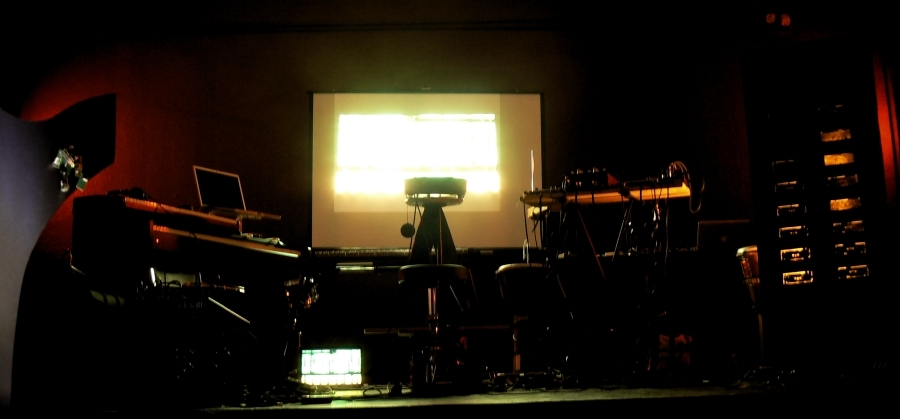Noise of the Modern Day World

Noise of the Modern Day World is the third installation performance by Decomposing Pianos, held on August 18th, 2011
at the Upper Canada Academy of Performing Arts.
Modern day instruments were sampled and recently outdated circuitry was used as a video backdrop.

I Analogue Overture (0:00 to 5:29)
the acoustic piano and highway infrastructure
Midnight traffic traveling down the 401 pass the sound of crickets in the median, as recorded from an overpass. An acoustic piano is played, together at first, until both players have left the piano for electronic gear and circuitry.
the acoustic piano and highway infrastructure
Midnight traffic traveling down the 401 pass the sound of crickets in the median, as recorded from an overpass. An acoustic piano is played, together at first, until both players have left the piano for electronic gear and circuitry.
II Digital Conversion (5:29 to 7:07)
the acoustic piano as a sampled machine
The end of the traditional acoustic instrument. Tones sampled from the 88 Years project are interwoven into noise. Each sample comes from an acoustic piano, mapped note by note to a digital keyboard.
the acoustic piano as a sampled machine
The end of the traditional acoustic instrument. Tones sampled from the 88 Years project are interwoven into noise. Each sample comes from an acoustic piano, mapped note by note to a digital keyboard.
III Mimicry by Machine (7:07 to 9:36)
technology as a new form of nature
Here we define our own surroundings by synthetically extending them from nature. The cyclic hum of electricity parallels insects beating in the late August heat. The low rumble of the Decomposing Piano is the last we hear before it is forgotten.
technology as a new form of nature
Here we define our own surroundings by synthetically extending them from nature. The cyclic hum of electricity parallels insects beating in the late August heat. The low rumble of the Decomposing Piano is the last we hear before it is forgotten.
IV Synthetic Approximation (9:36 to 13:47)
all things natural can be approximated by the synthetic
What was once acousticaly generated is now entirely synthetic. A melodic theme from Languishing Bellows is briefly heard through the oscillating tones of a synthesizer, crudely approximating a mechanical pump organ.
all things natural can be approximated by the synthetic
What was once acousticaly generated is now entirely synthetic. A melodic theme from Languishing Bellows is briefly heard through the oscillating tones of a synthesizer, crudely approximating a mechanical pump organ.
V Tools of Enhancement (13:47 to 25:38)
through technology we transcend ourselves
The human voice is sampled, but no one actually sings. At the height of our ordered environment, technological ideas and advancements transcend our biological restrictions and provide a new sense of clarity.
through technology we transcend ourselves
The human voice is sampled, but no one actually sings. At the height of our ordered environment, technological ideas and advancements transcend our biological restrictions and provide a new sense of clarity.
VI Noise of the Modern Day World (25:38 to 31:58)
through technology we lose ourselves
Technology thrives through order and predictable repetition. In complicated systems, error causes large scale ripple effects leading to loss of control and disaster. Organized sound becomes noise, and noise inevitably becomes silence.
through technology we lose ourselves
Technology thrives through order and predictable repetition. In complicated systems, error causes large scale ripple effects leading to loss of control and disaster. Organized sound becomes noise, and noise inevitably becomes silence.
Special thanks to Ian Montgomery and Chris Trimmer. One is a master of subtlety, adding texture on djembe with contact microphone and delay pedal.
The other, a master of audio processing, taking the raw signal from Part VI live on stage and decreasing our signal-to-noise ratio effectively.
TimKnightUs Forever.

